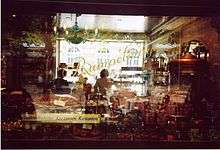Anton Rumpelmayer
Anton Rumpelmayer (13 February 1832 in Pressburg, Austria – 25 July 1914 in Saint-Martin-Vésubie, France) was an Austrian confectioner and k.u.k. Hoflieferant ("Purveyor to the Royal and Imperial Court", equivalent in the United Kingdom to holding a Royal warrant of appointment). He worked in France, where he was known as Antoine Rumpelmayer.
Anton Rumpelmayer | |
|---|---|
 Rumpelmayer patisserie in Baden-Baden (2008) | |
| Born | 13 February 1832 |
| Died | 25 July 1914 (aged 82) |
| Nationality | Austrian |
| Other names | Antoine Rumpelmayer |
| Occupation | Confectioner |
| Known for | High-class cafés |
Biography
In 1870, the confectioner Rumpelmeyer moved from Pressburg (now Bratislava, Slovakia) – others say from Upper Austria – to the French Riviera. He probably first worked in Viktor Sylvain Perrimond's business in Menton. In 1896 they founded the Perrimond-Mayer company and opened new shops in Cannes, Nice and Aix-les-Bains.[1] The Rumpelmayer establishment at 107 Avenue du Général du Gaulle in Aix was opened in 1887. It is still open today.[2]
Empress Elisabeth of Austria-Hungary often visited the area. In the course of these travels, she visited the Rumpelmayer establishment, and as a result, he was received at the Vienna Court to be awarded the honour of Hofzuckerbäcker ("Confectioner to the Court"). He was awarded this in 1896 by the Empress in person and is thus one of the very few whose award was made verbally by an imperial majesty. Rumpelmayer's partner received the honour at the same time.
In Dresden, Conditorei Rumplelmayer GmbH ran its own factory producing chocolate candies, fruit preserves and a sweet pastries. The company had branches in Baden-Baden, Bad Nauheim, Frankfurt and Berlin (at 208/209 Kurfürstendamm).[3] The Rumpelmayer in Baden-Baden is still open.[4] Rumpelmayer was also Purveyor to the Court of Baden and Saxony.
In 1903, Rumpelmayer opened a shop at 226 Rue de Rivoli in Paris and another branch with his son René. From 1916 his widow Angelina (née Guillarmou) took over. The Angelina tea house became the meeting place of Parisian high society, and is still open.
Further Rumpelmayer Cafés opened, operated either directly or as franchises. The one in St James's Street, London became a household name.[5] Its delivery service even found its way into literature: it is mentioned several times in Virginia Woolf's novel Mrs Dalloway.[6]
Another café was located in the Hotel St. Moritz at Central Park in New York City. It opened at the same time as the hotel in early 1930. The architect Winold Reiss designed the building in the Art Déco style.[7] The café closed, with the hotel, in the 1990s.[8]
References
- Bastard, Algernon (2007). The Gourmet's Guide to Europe. Echo Library. pp. 36, 38. Retrieved 21 April 2010.
To keep up the illusion that Aix-les-Bains is a part of the Riviera, there is a Rumpelmayer cake-shop within two minutes' walk of the Villa des Fleurs.
- "Répertoire des autorisations de voirie et permis de constuire 1842-2003. Répertoire par rues" (PDF). Archives Municipales d'Aix-les-Bains (in French). 12 August 2008. Archived from the original (PDF) on 2008-11-20. Retrieved 21 April 2010.
- "Cafés gestern und heute". Lexikon: Charlottenburg-Wilmersdorf von A bis Z. Bezirksamt Charlottenburg-Wilmersdorf von Berlin (in German). 21 April 2009. Retrieved 21 April 2010.
- ""Adel verpflichtet" - Die Confisserie Rumpelmayer in Baden-Baden". Kurhaus Baden-Baden (in German). 21 April 2009. Archived from the original on 17 May 2011. Retrieved 21 April 2010.
- Sheppard, F. H. W., ed. (1960). "St. James's Street, West Side, Existing Buildings". Survey of London: volumes 29 and 30. English Heritage. pp. 472–486. Retrieved 20 April 2010.
The site of Nos. 71–73 (consec.) St. James's Street and 3–6 (consec.) Little St. James's Street was cleared in 1908, and a new block of buildings completed in the following year. (ref. 28) The architects were William Woodward and Sons of Southampton Street, Strand, and the builders Messrs. Perry and Co. Ltd. of Bow. The upper floors were designed as residential chambers and the ground floor and basement as a shop for Rumpelmayer's celebrated confiserie. (ref. 29) This building was designed in the 'François Premier' style, perhaps to suit Rumpelmayer's salons-de-thé.
- Woolf, Virginia (14 May 1925). Mrs Dalloway. Hogarth Press. ISBN 0-15-662870-8.
- "Chronology". The Reiss Partnership. 5 November 2009. Retrieved 20 April 2010.
- Strum, Charles (6 February 2000). "Where Have All the Teddy Bears Gone?". The New York Times. Retrieved 28 April 2010.
Further reading
- Haslinger, Ingrid; Patka, Erika; Jesch, Marie-Luise (1996). Der süße Luxus. Die Hofzuckerbäckerei und die ehemaligen k. u. k. Hofzuckerbäcker Demel, Gerbeaud, Gerstner, Heiner, Rumpelmayer, Sluka (in German). Vienna: Kulturkreises Looshaus – Geyer & Reisser. ISBN 3-9500302-4-7.
- Haslinger, Ingrid (1996). Kunde – Kaiser. Die Geschichte der ehemaligen k. u. k. Hoflieferanten (in German). Vienna: Schroll. ISBN 3-85202-129-4.
External links
| Wikimedia Commons has media related to Anton Rumpelmayer. |